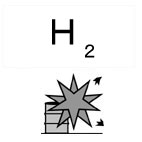| Case Name |
Fire and explosion of high-pressure hydrogen caused due to failure of a stopping operation of a feed pump of raw oil at a demonstration unit for catalytic cracking of a residue |
| Pictograph |

|
| Date |
March 18, 1988 |
| Place |
Kurashiki, Okayama, Japan |
| Location |
Refinery |
| Overview |
While a demonstration unit of catalytic cracking of vacuum residual oil was shut down, the operators reduced the discharge pressure of the feedstock feed pump. Therefore, even though a check valve was mounted, high-pressure hydrogen-rich gas flowed back, flowed into the feedstock surge drum through a circulation line, a rupture occurred and a fire broke out. This is a case of some mistakes overlapping. |
| Incident |
A fire broke out during shut-down operation in a unit for a demonstration of new technology of catalytic cracking of vacuum residual oil. As high-pressure hydrogen gas in the reaction system flowed back into a feedstock surge drum, and then flowed into the cooling oil receiver. Then the pressure of the cooling oil receiver increased and the oil blew out. Furthermore, the feedstock surge drum ruptured and a fire occurred. |
| Processing |
Research and Development |
| Process Flow |
Fig2.Unit flow sheet
|
| Substance |
Vacuum residue (Asphalt) |
| Hydrogen |
| Type of Accident |
Leakage, explosion, fire |
| Sequence |
On March 18th, 1988; piping used in a shutdown operation were substituted with heavy gas oil piping in the morning.
13:00; a shift leader ordered two operators to stop the feedstock feed pump.
13:08; one of the operators checked the discharge pressure, which was 19 MPa, and directed the other operator to open the circulation line valve to the feedstock surge drum.
After they informed the control room, they started the operation of opening the valve on the circulation line.
13:15; as the discharge pressure fell to 1.65 MPa, they began to close the valve at the discharge side of the pump.
13:16; when the spindle stroke of the discharge valve was 50%, they found oil blowing out from the manhole of the cooling oil receiver.
13:17; they informed to the control room of the oil blowout. When they ran to the site to check what had happened, the feedstock surge drum burned out. |
| Cause |
High-pressure gas in the reaction system flowed back into the feedstock surge drum. Then the oil blew out from the feedstock surge drum of the atmospheric pressure design and the cooling oil receiver of which the pressure was equalized with the feedstock surge drum. The circulation line valve was opened too wide, the discharge valve was not closed sufficiently, and there was a leakage in the check valve. |
| Response |
Emergency shutdown |
| Countermeasures |
A restriction orifice should be installed in the circulation line piping.
A check valve should be replaced.
The back-flow monitoring system should be changed, and the emergency shutdown valve should be reviewed.
Operation standards have to be revised, even though this is not mentioned in information source materials. |
| Knowledge Comment |
Check valves sometimes do not work well when it is necessary. An operation manual on actions to be taken assuming the check valve does not work is needed.
It should not be forgotten that fluid flows from high-pressure to low-pressure. |
| Background |
It is a basic operation to cut the flow with maintaining discharge pressure using a circulation line before the high-pressure pump shutdown. As there was an error in the operation procedure, the pressure could not be maintained. A deficiency in operation was one of the problems. In this case, the operator should have worked on the assumption that the check valve might not work well. Lack of education and training can be considered. It was also be a problem that the stopping operation depended on man power only.
Basically, the order of switching valves was wrong. When operating a valve, the supply side valve is supposed to be closed first, and when the discharge pressure increased, the circulation line valve should be opened a little to return the pressure to regular pressure. This procedure should be repeated. The discharge pressure of the pump must not be less than the pressure in the reaction system. |
| Incidental Discussion |
A pump, which needs to be stopped with keeping pressure and flow-rate of discharge, can be designed without depending only on man power. For example, a control valve can be installed in the circulation line and control the total flow rate of discharge so that it can be stabilized by valve operation. |
| Reason for Adding to DB |
Example of accident caused due to continuous mistakes |
| Scenario |
| Primary Scenario
|
Poor Value Perception, Poor Safety Awareness, Inadequate Risk Recognition, Organizational Problems, Poor Management, Inadequate Operation Manual, Carelessness, Insufficient Understanding, Insufficient Recognition of Risk, Planning and Design, Poor Planning, Poor Design, Regular Operation, Nonobservance of Procedure, Bad Event, Mechanical Event, Reverse Flow, Failure, Large-Scale Damage, Rapture, Secondary Damage, External Damage, Fire, Bodily Harm, Injury, 2 person injured
|
|
| Sources |
The high pressure gas safety institute of Japan, "The high-pressure gas safety overview," pp.136-137(1989)
The high pressure gas safety institute of Japan, Feed stock feed pump at vacuum residue catalytic cracking performance demonstration unit, Explosion and fire in the vacuum residue catalytic cracking performance demonstration unit, Accident case of Petroleum refinery and Petrochemical units, pp.57-59(1995)
|
| Number of Injuries |
2 |
| Physical Damage |
A feedstock surge drum was damaged. |
| Notes |
Poor maintenance, error in judgment. |
| Field |
Chemicals and Plants
|
| Author |
WADA, Yuji (National Institute of Advanced Industrial Science and Technology)
TAMURA, Masamitsu (Center for Risk Management and Safety Sciences, Yokohama National University)
|
|